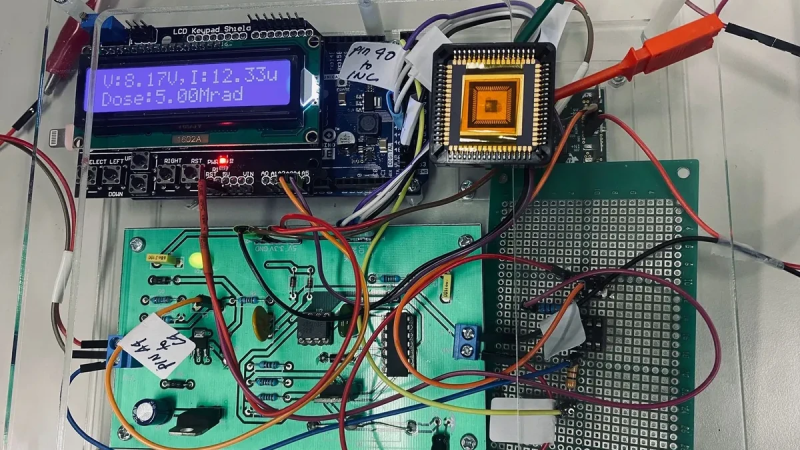Space is a challenging environment for semiconductors, but researchers have shown that a specific type of memristor (the hafnium oxide memristor, to be exact) actually reacts quite usefully when exposed to gamma radiation. In fact, it’s even able to leverage this behavior as a way to measure radiation exposure. In essence, it’s able to act as both memory and a sensor.
Being able to resist radiation exposure is highly desirable for space applications. Efficient ways to measure radiation exposure are just as valuable. The hafnium oxide memristor looks like it might be able to do both, but before going into how that works, let’s take a moment for a memristor refresher.
A memristor is essentially two conductive plates between which bridges can be made by applying a voltage to “write” to the device, by which one sets it to a particular resistance. A positive voltage causes bridging to occur between the two ends, lowering the device’s resistance, and a negative voltage reverses the process, increasing the resistance. The exact formulation of a memristor can vary. The memristor was conceived in the 1970s by Leon Chua, and HP Labs created a working one in 2008. An (expensive) 16-pin DIP was first made available in 2015.
A hafnium oxide memristor is a bit different. Normally it would be write-once, meaning a negative voltage does not reset the device, but researchers discovered that exposing it to gamma radiation appears to weaken the bridging, allowing a negative voltage to reset the device as expected. Exposure to radiation also caused a higher voltage to be required to set the memristor; a behavior researchers were able to leverage into using the memristor to measure radiation exposure. Given time, a hafnium oxide memristor exposed to radiation, causing it to require higher-than-normal voltages to be “set”, eventually lost this attribute. After 30 days, the exposed memristors appeared to recover completely from the effects of radiation exposure and no longer required an elevated voltage for writing. This is the behavior the article refers to as “self-healing”.
The research paper has all the details, and it’s interesting to see new things relating to memristors. After all, when it comes to electronic components it’s been quite a long time since we’ve seen something genuinely new.
















There is a company called “Knowm Inc.” that sells something called the “Memristor Discovery” board for $365.00 USD.[1][2][3]
Knowm Inc. has done some interesting work with the behavioral modelling of various memristors in LTspice.[4][5][6]
References (sorry for the odd nomenclature, but WordPress Jetpack will not let me simply make a numbered-list; not that it’s impossible to do, someday I’ll try):
[One] Knowm Inc. Home
http://knowm.org/
[Two] Knowm Inc. About
https://knowm.org/about/
Knowm Inc. exists to lead the computing industry toward neuromemristive processors. Our roots were planted in 2002, when lead inventor Alex Nugent began patenting his ideas around adaptive computing architectures and founded an intellectual property holding company called KnowmTech LLC with partners. Initial seed funding for the endeavor was made possible by business woman and entrepreneur, Hillary Riggs. Intellectual property services were provided by patent attorneys Kermit Lopez and Luis Ortiz. The IP portfolio spans memristive components and circuits all the way to large scale neuromorphic architectures… Read on.
[Three] Memristor Discovery (Board, Chip, Software, Manual) $365.00 + shipping & tax
https://knowm.com/products/memristor-discovery-board-chip-manual
[Four] The Joglekar Resistance Switch Memristor Model in LTSpice | The non-linear ion drift memristor model in SPICE
https://knowm.org/the-joglekar-resistance-switch-memristor-model-in-ltspice/
[Five] Memristor Models in LTSpice | Running Yakopcic’s models and creating the Knowm model
https://knowm.org/memristor-models-in-ltspice/
[Six] Chris Yakopic Ph.D. | Electrical Engineering Research (much on memristors).
https://cyakopcic1.wordpress.com/
Trying a simple HTML ordered list in the infernal WordPress Jetpack (of course there’s no preview):
Coffee
Tea
Milk
Well it worked (sort of), but the numbers vanished. Grrr….
I recently built a meristor emulator based on FRAM and SSRs: https://www.youtube.com/watch?v=xvpirQaqNCo
At the moment I am working on a novel bistable photochromic dye memristor.
Is that displaying a real dose? 5.00 Mrad? (=50 kGy!) Lethal human radiation dose is less than the rounding error!
Appears so –
“The researchers treated the memristor with 5 megarads of radiation—500 times as much as a lethal dose in humans.”
https://spectrum.ieee.org/memristor-2669280762
gamma ray EPROM?
“but researchers discovered that exposing it to gamma radiation “
kinda weird a researcher on a whim thought that might be something to do.
Answer: if you’re playing with semiconductors for space use, that’s what ya do
one
two
three
hmmm.